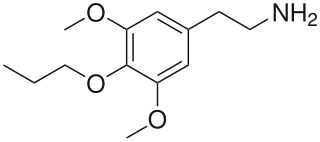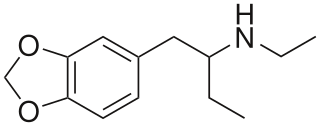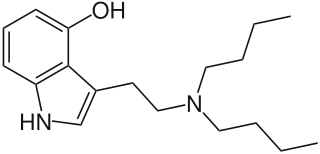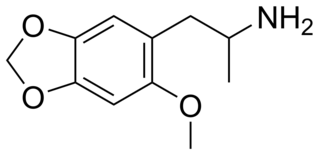
2C-T-7 is a psychedelic phenethylamine of the 2C family. In his book PiHKAL: A Chemical Love Story, Alexander Shulgin lists the dosage range as 10 to 30 mg. 2C-T-7 is generally taken orally, and produces psychedelic and entactogenic effects that last 8 to 15 hours. Up until Operation Web Tryp and three deaths, two of which involved the use of other drugs in addition to 2C-T-7, and one which involved an excessive insufflated dose, 2C-T-7 was sold commercially in Dutch and Japanese smartshops and online. It is known on the streets as Blue Mystic or 7th Heaven. There has been little real research done on this chemical other than Shulgin's comments in PiHKAL and a few small animal studies mostly aimed at detecting metabolites.

2C-T-8 is a psychedelic phenethylamine of the 2C family. It was first synthesized by Alexander Shulgin, sometimes used as an entheogen.

2C-T-4 (2,5-dimethoxy-4-isopropylthiophenethylamine) is a psychedelic phenethylamine of the 2C family. It was first synthesized by Alexander Shulgin and is used as entheogenic recreational drug.

Proscaline (4-propoxy-3,5-DMPEA) is a psychedelic and hallucinogenic drug. It has structural properties similar to the drugs mescaline, isoproscaline, and escaline. In PiHKAL, Alexander Shulgin reports that a dose of 30–60 mg produces effects lasting 8–12 hours.

2,5-Dimethoxy-4-ethylamphetamine is a psychedelic drug of the phenethylamine and amphetamine chemical classes. It was first synthesized by Alexander Shulgin, and was described in his book PiHKAL.
Ganesha (2,5-dimethoxy-3,4-dimethylamphetamine) is a lesser-known psychedelic drug. It is also a substituted amphetamine. It was first synthesized by Alexander Shulgin. In his book PiHKAL, the dosage range is listed as 24–32 mg. The drug is usually taken orally, although other routes such as rectally may also be used. Ganesha is synthesized from 2,5-dimethoxy-3,4-dimethylbenzaldehyde. Ganesha is the amphetamine analog of 2C-G. It is a particularly long lasting drug, with the duration listed in PiHKAL as being 18–24 hours, which might make it undesirable to some users. It is named after the Hindu deity, Ganesha. Very little is known about the dangers or toxicity of ganesha. Effects of ganesha include:

Aleph is a psychedelic hallucinogenic drug and a substituted amphetamine of the phenethylamine class of compounds, which can be used as an entheogen. It was first synthesized by Alexander Shulgin. In his book PiHKAL, Shulgin lists the dosage range as 5–10 mg. According to Shulgin, the effects of aleph typically last for 6 to 8 hours.

2C-T-15 or 2,5-dimethoxy-4-(β-cyclopropylthio)phenethylamine is a psychedelic phenethylamine of the 2C family. It was presumably first synthesized by Alexander Shulgin and reported in his book PiHKAL .

2C-T-17 or 2,5-dimethoxy-4-(β-secbutylthio)phenethylamine is a psychedelic phenethylamine of the 2C family. It was presumably first synthesized by Alexander Shulgin and reported in his book PiHKAL .

3,4-Methylenedioxy-N-propylamphetamine is a lesser-known psychedelic drug and a substituted amphetamine. MDPR was first synthesized by Alexander Shulgin. In his book PiHKAL, the minimum dosage is listed as 200 mg, and the duration unknown. MDPR is a promoter; by itself it has almost no effects on the mind, but it promotes the effects of hallucinogens, similarly to the closely related MDPH.

Ariadne is a lesser-known psychedelic drug. It is a homologue of 2C-D and DOM. Ariadne was first synthesized by Alexander Shulgin. In his book PiHKAL, Shulgin reported testing Ariadne up to a dose of 32 mg, and reported that it produces psychedelia at a bare threshold. Very little data exists about the pharmacological properties, metabolism, and toxicity of Ariadne in humans apart from Shulgin's limited testing.

2-Bromo-4,5-methylenedioxyamphetamine (6-Bromo-MDA) is a lesser-known psychedelic drug and a substituted amphetamine. It was first synthesized by Alexander Shulgin. In his book PiHKAL, the dose is listed as 350 mg and the duration unknown. It produces stimulant effects but with no psychedelic or empathogenic action. Very little data exists about its pharmacological properties, metabolism, and toxicity.

2,5-Dimethoxy-4-propylamphetamine (DOPR) is a psychedelic drug of the phenethylamine and amphetamine chemical classes. It was first synthesized by Alexander Shulgin, and was described in his book PiHKAL. Shulgin described DOPR is a "heavy duty psychedelic", complete with alterations of the thought process and visual distortion. Very little data exists about the pharmacological properties, metabolism, and toxicity of DOPR.

2,5-Dimethoxy-4-ethoxyamphetamine (MEM) is a psychedelic drug of the phenethylamine and amphetamine chemical classes. It was first synthesized by Alexander Shulgin. In his book PiHKAL, he lists the active dose range as 20–50 mg, and the duration as 10–14 hours. According to Shulgin, MEM produces color enhancement, visual phenomena, and pattern movement, among other effects.

Ethylbenzodioxolylbutanamine is a lesser-known entactogen, stimulant, and psychedelic. It is the N-ethyl analogue of benzodioxylbutanamine, and also the α-ethyl analogue of methylenedioxyethylamphetamine.

F-2, or 6-(2-aminopropyl)-5-methoxy-2-methyl-2,3-dihydrobenzofuran, is a lesser-known psychedelic drug. F-2 was first synthesized by Alexander Shulgin. In his book PiHKAL, the minimum dosage is listed as 15 mg, and the duration unknown. F-2 produces few to no effects at this dose in humans. Animal studies showed it to substitute for the psychedelic drug DOM, but with less than one tenth the potency.
TOM, or methylthio-methyl-methoxyamphetamine, is a series of lesser-known psychedelic drugs and substituted amphetamines with the molecular formula C12H19NOS. 2-TOM and 5-TOM are the 2- and 5-methylthio analogs of 2,5-dimethoxy-4-methylamphetamine (DOM), respectively. They were first synthesized by Alexander Shulgin and described in his book PiHKAL. Very little is known about their dangers or toxicity.

4-Hydroxy-N,N-dibutyltryptamine (4-HO-DBT) is a psychedelic drug belonging to the tryptamine family. It is found either as its crystalline hydrochloride salt or as an oily or crystalline base. 4-HO-DBT was first made by the chemist Alexander Shulgin and reported in his book TiHKAL. Shulgin reported a dosage of 20 mg orally to be without effects. However this compound has subsequently been sold as a "research chemical" and anecdotal reports suggest that at higher doses 4-HO-DBT is indeed an active hallucinogen, although somewhat weaker than other similar tryptamine derivatives.

MMDA-2 (2-methoxy-4,5-methylenedioxyamphetamine) is a psychedelic drug of the amphetamine class. It is closely related to MMDA and MDA.

2,5-Dimethoxy-4-fluoroamphetamine (DOF) is a psychedelic drug of the phenethylamine and amphetamine classes. Alexander Shulgin briefly describes DOF in his book PiHKAL:
Animal studies that have compared DOF to the highly potent DOI and DOB imply that the human activity will be some four to six times less than these two heavier halide analogues.


















